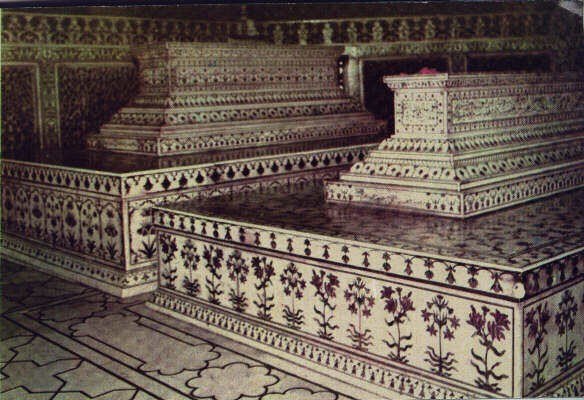

Taj Mahal Interior
The interior of
the
mausoleum consists of a lofty central chamber beneath the
towering
dome, a crypt immediately below this, and four octagonal
corner rooms
arrayed around the central crypt.. There is some
disagreement as to
their purpose. It is believed by many they were intended to
house the
graves of other royal family members. However, it appears
they were
used instead for the mullahs to chant the Koran and for
musicians, who
played soft Indian and Persian melodies. The photo to the
left shows
the layout of the Taj Mahal's interior, while the photo to
the right
shows one of the screened hallways linking these exterior
rooms. In the center are the
cenotaphs of Shah Jahan and Mumtaz Mahal. (photo at bottom
left) Shah
Jahan's cenotaph is to the left and
is higher than that of his beloved Mumtaz,
which rests
immediately below the dome. The cenotaph of Mumtaz Mahal stands in the center of the marble
screen, and
has Koranic inscriptions written
in Persian. The couple are not buried there, but below
ground in an
innocuous tomb. Some dispute this, pointing out that many
Mughul
mausoleums sported a third burial chamber containing the
remains. It
has been
 determined that
there is a third area, sealed off long ago,
although it is not certain that it in fact contains any
remains. Above
the tombs is a Cairene lamp, the flame of which is
supposed to never
burn out. Marble screen of trelliswork surrounds the
graves. Both tombs
are exquisitely inlaid with semi precious stones. The
acoustics of the
building are superb with the domed ceiling being designed
to echo
chants from Koran and musician's melodies. A pearl-shaped
dome crowns
the Taj Mahal The height from the base of the dome to the
pinnacle is
44 meters (145 feet). The dome, in addition to
creating a open
area to properly display the cenotaphs, creates an
acoustically
sensitive area where even the slightest whisper can be
heard. A more
detailed tour of the interior can be gleaned from Vic
Stefanu's video,
shown below.
determined that
there is a third area, sealed off long ago,
although it is not certain that it in fact contains any
remains. Above
the tombs is a Cairene lamp, the flame of which is
supposed to never
burn out. Marble screen of trelliswork surrounds the
graves. Both tombs
are exquisitely inlaid with semi precious stones. The
acoustics of the
building are superb with the domed ceiling being designed
to echo
chants from Koran and musician's melodies. A pearl-shaped
dome crowns
the Taj Mahal The height from the base of the dome to the
pinnacle is
44 meters (145 feet). The dome, in addition to
creating a open
area to properly display the cenotaphs, creates an
acoustically
sensitive area where even the slightest whisper can be
heard. A more
detailed tour of the interior can be gleaned from Vic
Stefanu's video,
shown below.